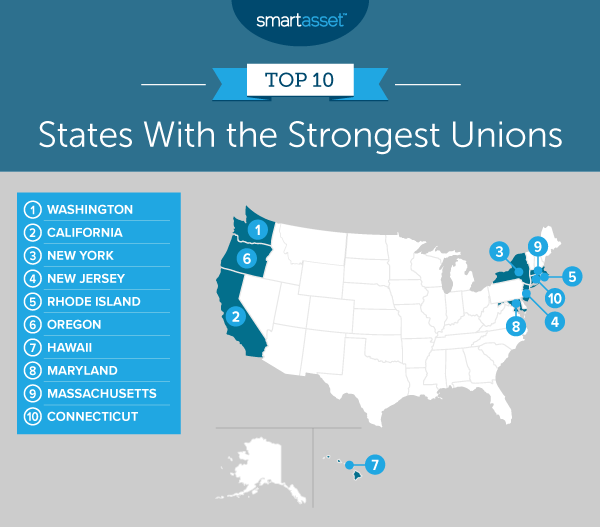Unions can be a great way for workers to gain power in the workplace and make sure they are treated and compensated fairly. Overall, union participation rates in the U.S. are down: In 2018 the rate was 10.5%, while in 1983 it was 20.1%, according to the Bureau of Labor Statistics (BLS). Still, there are some places where unions are stronger than others. That’s why SmartAsset decided to crunch the numbers and find the states with the strongest unions.
To do so, we looked at data for all 50 states across the following eight metrics: number of union members, percentage of workers who are union members, four-year change in union membership, average annual wage for all occupations, average annual wage for middle school teachers, salary ratio of middle school teachers to all occupations, average wage for firefighters and salary ratio of firefighters to all occupations. We looked specifically at teachers and firefighters, because these two professions generally have the highest unionization rates, according to the BLS. For details on our data sources and how we put all the information together to create our final rankings, check out the Data and Methodology section below.
This is SmartAsset’s 2020 edition of our study on the states with the strongest unions. Read the 2019 edition here.
Key Findings
- The coasts boast strong unions. As in previous editions of this study, the two coasts dominate the top of the list. In the top 10, all but one of the states is on the East or West Coast. Hawaii is the only outlier that is not on either coast of the continental U.S.
- Teacher salaries across the country exceed average salaries across all occupations. In all but two states, middle school teachers make more than the average worker across all occupations. In Colorado, their salary comprises only about 95% of the average salary for all occupations, and in Arizona it comprises about 89%.

1. Washington
Leading the way in the study once again is Washington State, which ranks in the top six of the study for six out of the eight metrics we considered. More specifically, 18.80% of workers are in unions, the third-highest rate in this study. Washington ranks second overall for the four-year change in union membership, which increased by 27.63% from 2015 to 2019. The average annual wage for all workers in Washington is $62,020, the fourth-highest in our study.
2. California
California leads the study in terms of its total number of union members, at nearly 2.5 million. It also ranks seventh-highest for the percentage of workers in unions, at 15.14%, and first for the average wage for firefighters, at $84,370.
3. New York
New York has the second-highest total union membership in this study, at more than 1.7 million members. The Empire State also has the second-highest percentage of workers in unions, 20.98%. Unlike in many states at the top of our list, though, the number of workers in unions is going down in New York, dropping nearly 15% over the past four years.
4. New Jersey
New Jersey firefighters have an average annual wage of $80,890 – the second-highest in the study. That figure is more than 134% of the average wage for all occupations, the third-best ratio for this metric across all states. The Garden State’s union participation rate is 15.68%, the sixth-highest in the study.
5. Rhode Island
Rhode Island’s union participation rate is 17.39%, the fourth-highest rate in this study. Total union membership has gone up 20.50% in the four-year period from 2015 to 2019, the sixth-highest rate of improvement out of all 50 states. Middle school teachers in Rhode Island make $75,130 on average, and middle school teacher salaries are 131.30% of the average salary for all workers – putting the state at No. 6 and No. 4, respectively, for these metrics.
6. Oregon
Oregon firefighters make $68,540 each year on average, the sixth-highest total earnings for firefighters in the study. That figure represents 127.19% of the average salary for all workers, which is fourth-highest in the study. Oregon also places 10th overall in terms of the percentage of workers in unions, with a rate of 14.38%.
7. Hawaii
The Aloha State has the highest union participation rate in the country, at 23.38%. Union membership has gone up 13.42% from 2015 to 2019, the 12th-highest increase in that time. Firefighters in Hawaii do fairly well for themselves, with an average annual salary of $64,110, which is 116.71% of the average worker’s salary across all occupations. That places the state eight-best and seventh-best for those two metrics, respectively.
8. Maryland
Maryland workers do well on the whole – the average annual salary across all occupations is $60,230, the sixth-highest in the nation. The state ranks in the top 15 for the total number of union workers (more than 328,000), and it ranks in the top 20 for the percentage of workers in unions (at 11.30%).
9. Massachusetts
Massachusetts workers have the highest average salary across all occupations in the nation – $65,680. The Bay State also pays teachers well, with an average salary for middle school teachers of $80,520, ranking third in this category. Nearly 12% of workers in Massachusetts are in unions, which is the 15th-highest rate for this metric in the study.
10. Connecticut
Connecticut has a union participation rate of 14.51%, the ninth-highest in the nation. The average annual wage in Connecticut is $62,350, third-best across all 50 states. Teachers in particular may like living in Connecticut, as it has the fifth-highest average annual wage for middle school teachers, at $79,150.

Data and Methodology
To find the states with the strongest unions, SmartAsset considered data from all 50 states across the following eight metrics:
- Number of union members. Data comes from UnionStats.com and is for 2019.
- Percentage of workers who are union members. Data comes from UnionStats.com and is for 2019.
- Four-year change in union membership. Data comes from UnionStats.com and is for 2015 and 2019.
- Average annual wage for all occupations. Data comes from the Bureau of Labor Statistics (BLS) and is for 2019.
- Average annual wage for middle school teachers. Data comes from the BLS and is for 2019. According to the BLS, among occupational groups, one of the highest unionization rates in 2019 was in education, training and library occupations. Middle school teacher is a prominent occupation within that industry. Workers in this job tend to make middle-range salaries for all occupations within the industry.
- Salary ratio for teachers to all occupations. Data comes from the BLS and is for 2019.
- Average annual wage for firefighters. Data comes from the BLS and is for 2019. According to the BLS, among occupational groups, one of the highest unionization rates in 2019 was in protective service occupations. Firefighter is a prominent occupation within that industry. Workers in this job tend to make middle-range salaries for all occupations within the industry.
- Salary ratio for firefighters to all occupations. Data comes from the BLS and is for 2019.
First we ranked each state in each metric. We then found the average ranking for each state, giving each state equal weight, except for the percentage of workers in unions, which received a double weight, and the four metrics regarding average annual wages and salary ratios for middle school teachers and firefighters to the average salary of all occupations, each of which received a half weight. We then used the average rankings to create our final rankings. The state with the highest average ranking received a score of 100, and the state with the lowest average ranking received a score of 0.
Tips for Making the Most of Your Money
- Invest in a smart financial partnership. Whether or not you are in a union, a financial advisor can help you make the most of your money. Finding a financial advisor doesn’t have to be hard. SmartAsset’s free tool connects you with financial advisors in your area in five minutes. If you’re ready to be matched with local advisors, get started now.
- Prioritize retirement. Many union jobs have pensions, but some may only have access to a workplace retirement plan like a 401(k), so make sure to take advantage of that if applicable.
- Reassess your budget if possible. If you aren’t earning enough to keep up with your bills, consider thinking about your spending by setting up a new budget for you and your family.
Questions about our study? Contact press@smartasset.com
Photo credit: ©iStock.com/designer491
